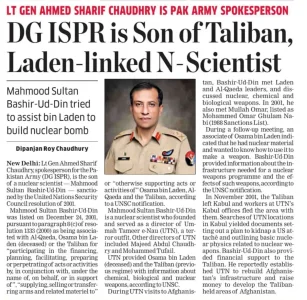- Joined
- Sep 29, 2024
- Messages
- 5,846
- Likes
- 31,542
Operation SINDOOR: India’s Strategic Clarity and Calculated Force
I am posting the 12 points about military action from this PIB press release below
Major point is official govt confirmation of Rafale, SCALP missile and Hammer bomb usage alongside fighter-jets blasted in hangar at PAF Bholari.
-----------------------------------------------------------------------------------------------------------------------
Nine Terror Camps Eliminated: India successfully destroyed nine major terror launchpads in Pakistan and Pakistan-occupied Jammu and Kashmir (PoJK), targeting Lashkar-e-Taiba, Jaish-e-Mohammed, and Hizbul Mujahideen facilities. Over 100 terrorists were killed in action.
Cross-Border Precision Strikes: India redefined the rules of engagement, striking deep into Pakistan’s heartland, including Punjab province and Bahawalpur, once considered out of bounds even for U.S. drones. India made it clear: neither the LoC nor Pakistani territory will remain untouched if terror originates from there.
A New Strategic Red Line: Operation SINDOOR drew a new red line- if terror is state policy, it will be met with a visible and forceful response. This marked a shift from deterrence to direct action.
Equal Punishment for Terrorists and Their Sponsors: India rejected the artificial separation between terrorists and their backers, striking both simultaneously. This ended the impunity enjoyed by many Pakistan-based actors.
Exposure of Pakistan’s Air Defense Weaknesses: Indian Air Force bypassed and jammed Pakistan’s Chinese-supplied air defense systems, completing the mission in just 23 minutes using Rafale jets, SCALP missiles, and HAMMER bombs, demonstrating India’s technological edge.
India’s Air Defense Superiority Displayed: India’s multi-layered air defense, including the indigenous Akashteer system, shot down hundreds of drones and missiles. This also showcased India’s growing capabilities in exporting advanced defense systems.
Precision Without Escalation: India avoided civilian or non-terror military targets, showcasing its zero-tolerance for terror while containing the situation from escalating into full-scale war.
Elimination of Key Terror Commanders: Multiple high-profile terrorists on India’s most wanted list were neutralized in a single night, crippling key operational modules. High-value targets eliminated include Yusuf Azhar, Abdul Malik Rauf, Mudassir Ahmad. These individuals were linked to the IC-814 hijack and Pulwama blast.
Airstrikes on Pakistani Military Installations: On May 9–10, India became the first country to strike 11 airbases of a nuclear-armed nation in a single operation, destroying 20% of Pakistan’s air force assets. High casualties were inflicted at Bhoolari Airbase, including the death of Squadron Leader Usman Yusuf and destruction of key fighter jets.
Coordinated Tri-Service Action – The Indian Army, Navy, and Air Force worked in full coordination, demonstrating India’s growing joint military prowess.
A Global Message Delivered – India showed the world that it does not require anyone’s permission to defend its people. It reinforced the idea that terrorists and their masterminds can’t hide anywhere, and if Pakistan retaliates, India is prepared for a decisive counterstrike.
Widespread Global Support – Unlike in previous conflicts, this time multiple global leaders backed India, rather than calling for restraint. The shift showed India’s improved global standing and narrative control.
Kashmir Narrative Reframed – For the first time, India’s actions were seen purely through the lens of counter-terrorism, with the Kashmir issue completely decoupled from the strike narrative. This was made possible by the precision and clarity of Operation SINDOOR.
----------------------------------------------------------------------------------------------------------------------



 and drones too stronk for paki islamic spirits
and drones too stronk for paki islamic spirits 

